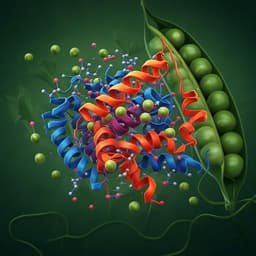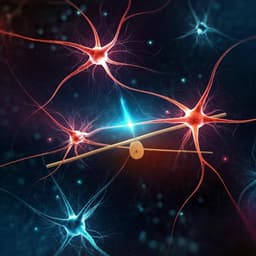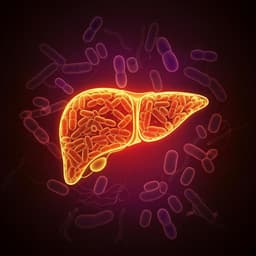
Physics
Memory of elastic collisions drives high minority spin and oscillatory entropy in underdamped chiral spinners
S. Li, T. V. Phan, et al.
Explore the intriguing dynamics of chiral spinners on an air table in this groundbreaking study by Shengkai Li, Trung V. Phan, Gao Wang, Ramzi Khuri, Jared W. Wilson, Robert H. Austin, and Liyu Liu. Discover the fascinating phenomenon of 'minority spin pumping' and the unexpected oscillations in entropy production within underdamped active matter. This research promises to challenge your understanding of spin dynamics!
Playback language: English
Introduction
The study of active matter, systems of self-propelled particles, has gained significant traction in recent years. Much of this research focuses on overdamped systems, where inertial effects are negligible. However, many real-world active matter systems exhibit significant inertia, leading to complex dynamics that are not captured by overdamped models. This paper addresses this gap by focusing on underdamped chiral active matter, specifically investigating the behavior of chiral spinners—objects that both translate and rotate—on an air table. The research question centers around understanding how the inertial memory of collisions influences the collective behavior of these spinners, particularly the distribution of spin and the evolution of entropy. The importance of this study lies in its potential to unravel the complex interplay between inertia, chirality, and collective behavior in active matter, phenomena with significant implications for diverse fields ranging from biological systems to the design of novel materials and micro-robotics. Understanding the dynamics of inertial chiral matter is crucial because inertia, which preserves the memory of past collisions, leads to irreversible motions. These irreversible processes are responsible for emergent phenomena such as turbulence in fluid dynamics, a complex area of ongoing research. While the significance of inertia is recognized, it is often ignored due to the computational challenges involved in predicting the future motion of particles with memory. In contrast, this paper tackles these challenges directly by exploring experimentally and theoretically how inertial spin-orbital angular momentum coupling affects the collective behavior of spinners, revealing unexpected phenomena unseen in overdamped systems. The paper's novelty lies in its focus on rotational (chiral) inertial underdamped aspects in elastic collisions—a less explored area of active matter research—despite the known rich collective behavior exhibited even by overdamped chiral systems.
Literature Review
Prior research on active matter has primarily concentrated on overdamped systems, simplifying the analysis but neglecting the significant impact of inertia. Recent studies, however, are beginning to investigate inertial effects, revealing phenomena absent in overdamped models. For example, these studies have shown that inertia can enhance motility-induced phase separations, diffusion rates, and alter stochastic dynamics. Most of this research, however, primarily focuses on linear inertial momenta, leaving the effects of rotational inertia in chiral systems relatively unexplored, despite the rich collective behavior observed even in overdamped chiral active matter. This study thus bridges this knowledge gap by experimentally investigating the interplay between inertial spin-orbital coupling and the unexpected emergent phenomena arising from this coupling in underdamped systems.
Methodology
The experimental setup consists of a collection of chiral spinners—7 cm diameter discs with toothed edges—floating on an air table. Each spinner is driven by two opposing air blowers, allowing for controlled rotation in either clockwise or counterclockwise directions. A binary barcode on each spinner enables tracking of its position and rotational speed using a camera system. The spinners' collisions are nearly elastic and underdamped, ensuring that the kinetic energy and angular momentum from previous collisions influence subsequent interactions. This setup allows the authors to carefully control the initial conditions, including the population ratio of clockwise and counterclockwise spinners and their initial spin states. Three key experiments were performed to test the theoretical predictions. Experiment 1 focused on minority spin pumping, investigating the distribution of spin among spinners with differing handedness. The authors manipulated the ratio of clockwise and counterclockwise spinners to observe this effect. Experiment 2 explored the mixing entropy and the emergence of vorticity. The spatial distribution and entropy of spinners were tracked over time, revealing oscillations associated with the formation of vortices. This experiment involved tracking the position of spinners and computing the positional entropy using a two-subsystem partition method. Experiment 3 examined the role of topology by confining four spinners within a circular boundary, limiting their spatial rearrangement and studying the impact on spin dynamics. This experiment tested the influence of spatial constraints on the observed phenomena. The experimental data are complemented by theoretical modeling and simulations. A theoretical model describing the collision dynamics, based on the conservation of angular momentum, is presented, predicting the transfer of angular momentum between colliding spinners. This model is validated against experimental data. Simulations were also employed to enhance the understanding of the complex system and to explore a wider range of conditions. These simulations employ a model that takes into account various forces (collision forces, air drag, driving torque from the blowers) influencing spinner motion and uses a symplectic integrator for improved accuracy. The model's parameters were extracted through measurements from the physical spinners. A key aspect of the simulation is the precise modelling of the interaction forces, involving line segment interactions based on the spinner geometry and utilizing a spring-dash model.
Key Findings
The study reveals several key findings. First, it demonstrates the phenomenon of minority spin pumping, where spinners with the lower population number exhibit significantly higher spin levels than the majority population. This effect is a direct consequence of the memory-preserving nature of underdamped collisions, leading to a net transfer of energy to the minority species. The authors derive a theoretical model based on angular momentum conservation (Eq. 1), validating it against experimental data. This model quantitatively predicts the spin redistribution during collisions and accurately captures the minority spin pumping effect. The model further provides equations (3, 4, 5) for estimations of average spinning velocity, total rotational energy, and orbital energy, demonstrating a good match with the experimental observations. Equation (2) describes the rotational motion of each spinner, including angular velocity change from collisions and effects of external torque and air drag. This model is successfully applied in various spin ratios to understand energy transfer in the system. Second, the study observes oscillations in the positional entropy of the spinner swarm. These oscillations are linked to the emergence of vorticity, most pronounced when the spinners have uniform handedness, leading to the transfer of global spin into global orbital angular momentum and the creation of a transient circulation. The oscillatory entropy is analyzed using Equation (6) for positional entropy, revealing that high spinner density is necessary for the oscillations and that the oscillation interval is related to the spin ratio (Figure 5). Experiment 2, focusing on mixing times, shows that these times depend on the initial spin ratio, peaking at even mixtures and being lowest when only one spinner type is present, suggesting slower evolution for even mixtures due to minimal spin-to-orbital energy transfer. The number of vortices also varies with the spin ratio, increasing substantially when the spin ratio is outside the region of non-oscillatory entropy increase. Third, the experiment exploring topological effects shows a pronounced influence of spinner arrangement on spin dynamics. Confining spinners within a ring reveals that parallel topologies favor spin annihilation and lower spin kinetic energy, while diagonal topologies promote high spin levels. The intermittent bursts of rotational energy observed in the ring configuration indicate frustration, indicating a system without a stable steady-state. The introduction of a confining ring allows observation of the transfer of spin energy to an outer ring, pointing towards a potential construction of scale-free fractal hierarchical structures using such a system. Simulations are used to verify these results and to study larger numbers of spinners to verify the scaling behavior of observed effects. The simulation results closely match experimental findings, confirming the conclusions.
Discussion
The findings of this study offer a profound insight into the dynamics of underdamped chiral active matter. The observation of minority spin pumping challenges the traditional notions of equipartition in statistical mechanics, highlighting the crucial role of inertial memory in shaping energy distributions. The emergence of vorticity and the oscillations in mixing entropy further underscore the counter-intuitive behavior of systems with memory. The significant influence of topology and initial conditions adds complexity to the dynamics, revealing a rich landscape of possible emergent behaviors. These findings have implications for a broad range of fields including active matter physics, soft condensed matter, and the design of self-organizing systems. The unique behavior observed here emphasizes the importance of accounting for inertial effects in studying active matter, particularly systems exhibiting chirality. Future work could extend the study to even larger systems and explore the thermodynamic limit, investigate the criticality of the spin ratio, and delve further into the underlying mathematical structures governing the entropy oscillations.
Conclusion
This study demonstrates that the memory of elastic collisions significantly impacts the collective behavior of underdamped chiral spinners. The observed minority spin pumping, oscillatory entropy, and sensitivity to topology illustrate the limitations of traditional statistical mechanics in explaining such systems. Future research should explore the applicability of these findings to other active matter systems and investigate the potential for creating more complex, programmable self-organizing structures based on chiral spinners.
Limitations
The experimental setup utilizes a relatively small number of spinners, and further research is needed to confirm the scaling of the observed phenomena to larger systems. The nearly elastic collisions in the experiment introduce some level of simplification, and future work could explore the influence of more realistic collision parameters. The current simulations assume simplified models for forces between spinners. More refined force models may be necessary for accurate prediction of system behavior under complex conditions.
Related Publications
Explore these studies to deepen your understanding of the subject.







